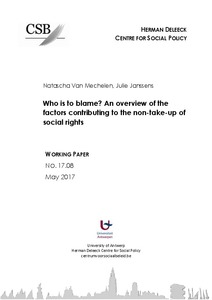Who is to blame? An overview of the factors contributing to the non-take-up of social rights
"This article aims to provide an overview of the main mechanisms underlying non-take-up by bringing together insights from existing theoretical models and the large body of empirical evidence. We draw on studies based on the traditional model of economic rationality as well as on behavioural ec...
| Main Authors: | , , |
|---|---|
| Institution: | ETUI-European Trade Union Institute |
| Format: | TEXT |
| Language: | English |
| Published: |
Antwerp
2017
CSB |
| Subjects: | |
| Online Access: | https://www.labourline.org/KENTIKA-618712443699-Who-is-to-blame?-an-overview-o.htm |
| Summary: | "This article aims to provide an overview of the main mechanisms underlying non-take-up by bringing together insights from existing theoretical models and the large body of empirical evidence. We draw on studies based on the traditional model of economic rationality as well as on behavioural economics. The first strand of literature is based on the assumption that individuals are perfectly rational and therefore perfectly able to optimize the trade-off between costs and benefits. The second, and more recent perspective, focuses on important deviations from the traditional assumptions of rationality by pointing to the role of cognitive biases and behavioural barriers. An important focus of attention in this article is the way policy design and administrations can affect the uptake of public provisions. While the traditional approach tends to pay little attention to the design of public provisions and the role of administrations in improving participation rates, behavioural economics has shed light on the question of how to nudge and prime people into participating in public programmes without fundamentally changing their economic incentives (e.g. simply by changing the default settings in administrative procedures). In this literature review, we bring both strands in the literature together and develop a theoretical framework which lists and links the various mechanisms at play. At the same time, we summarise the most important empirical findings, and identify gaps in the literature. Finally, we pay attention to lessons from the literature regarding how policies could be redesigned to reduce non-takeup." |
|---|---|
| Physical Description: | 31 p. Digital |

